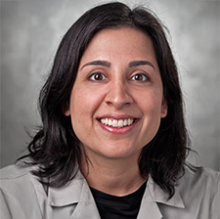One in eight women in the U.S. will be diagnosed with breast cancer. As government funding for this disease faces an uncertain future, the role of philanthropy foundations to push clinical trials forward for patients takes on new importance.
“We cannot push cancer research forward without the help of philanthropy,” said Amina Ahmed, MD, director of the Rush MD Anderson Cancer Center in Chicago.
For the last 40 years, the Lynn Sage Breast Cancer Foundation has raised more than $50 million for breast cancer. In 2024, it joined forces with Rush University System for Health, University of Chicago Medicine and the Robert H. Lurie Comprehensive Cancer Center of Northwestern University at Northwestern Medicine to convene the Chicago Breast Cancer Research Consortium, whose goal is to improve access to clinical trials for Chicago-area breast cancer patients.
Rush University System for Health is part of the AMA Health System Member Program, which provides enterprise solutions to equip leadership, physicians and care teams with resources to help drive the future of medicine.
Dr. Ahmed and other consortium leaders took part in a discussion hosted by City Club Chicago to offer more details about this model to transform breast cancer research.
Breaking down barriers
Rush University System for Health is familiar with collaborating with colleagues across various disease entities on a formal and informal business.
“We support second opinions. If there is a trial open at University of Chicago, I will send my patient there if we do not have it open at Rush,” Dr. Ahmed said.
What the consortium does is break down barriers across institutions, where all the researchers in the disease space of breast cancer can collaborate seamlessly and bring novel trials to patients without any issues across institutions.
“The consortium also provides opportunities for our young investigators, who may bring the most innovative ideas,” said Dr. Ahmed.
Having this consortium in the breast cancer space is novel for Chicago. Nevertheless, “such a model could be used as a blueprint to treat other disease entities in the coming years,” she said.
Supporting “thrivers” at all stages of disease
A chief goal is to put forward different investigator-initiated trials at institutions in the consortium that address different survivor or “thriver” issues, said Dr. Ahmed, an oncologist who specializes in treatment of older adults with ovarian cancer.
“We really do invest in primary oncology and we want to equally invest in the supportive realm in oncology because our patients are living longer and we want them to live better. Therefore, we invest in various programs to support our thrivers,” she said.
With survivors, it’s important to consider the physical, mental and emotional well-being before and after treatment, said Kunle Odunsi, MD, a gynecologic oncologist, another panelist at the event. He is the director of University of Chicago Medicine Comprehensive Cancer Center.
Some patients will be categorized as long-term survival. Some are shorter term.
“What kind of clinical trials can we design to help long-term survivors, short-term survivors? I am hoping that with this consortium we'll be able to cover the entire spectrum of helping survivors, whatever the stage is,” he said.

Embracing AI technologies
The panel also addressed the use of cell therapies and augmented intelligence (AI)—also known as artificial intelligence—in discussing breakthrough technologies in breast cancer treatment.
“When we started moving down the road of precision medicine, everything that we do when we treat patients with cancer is biomarker driven. That opens a large box of data for our physicians to go through,” said Dr. Ahmed.
There are tools that AI can provide for physicians to make their work much more seamless. AI tools, for example, can help identify patients who could be clinical trial eligible and might otherwise fall through the cracks, she said.
Dr. Ahmed and other panelists were quick to point out that AI does not replace the physician, the expert who is trained to take care of a patient.
AI clearly provides a way to enhance diagnostic capabilities, to quickly summarize any clinical data, said Leonidas C. Platanias, MD, PhD, a speaker at the Chicago City Club event, and director of the Robert H. Lurie Comprehensive Cancer Center of Northwestern University.
“I still believe though that research innovation, the major breakthroughs that will change medicine will still rely on the human factor. I don't think AI will be able to do that,” said Dr. Platanias.
From AI implementation to digital health adoption and EHR usability, the AMA is fighting to make technology work for physicians, ensuring that it is an asset to doctors.
Using different cell therapies
Dr. Ahmed is also excited about the use of different kinds of cell therapies, noting that “cell therapy is an avenue where we are utilizing patient’s tissue or their blood to transform those cells to then treat their cancer.
“It's standard in hematologic malignancies, but it is becoming more prevalent in the solid tumors,” she added.
Novel, innovative approaches to engineer immune cells is a big breakthrough area, noted Dr. Odunsi. Researchers have learned how to program those cells, to instruct the immune cells to go on the attack when a tumor is detected.
“These are beginning to get to the clinic and hopefully will be useful for many solid tumors including breast cancers,” he said.
Moving toward a national movement
Looking forward, Dr. Platanias hopes that foundations in other areas of the country will adopt the consortium’s model.
“It could be the beginning of a national effort. There are other cities in the country with high disparities, with similar problems with Chicago. And if this effort is successful in Chicago, it will create a new model that could be adapted in other cities,” he said.
Ideally there will be a multiplier effect, where the consortium’s work will generate new questions and potentially obtain even more funding to be able to test those questions and improve the outcome for patients, said Dr. Odunsi.




